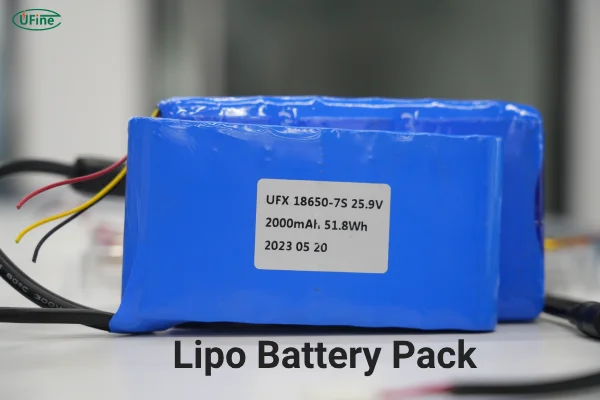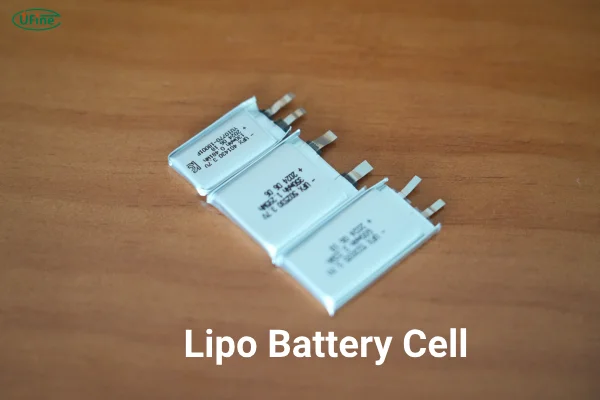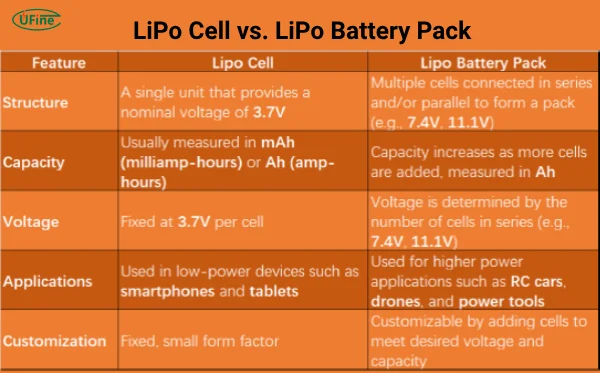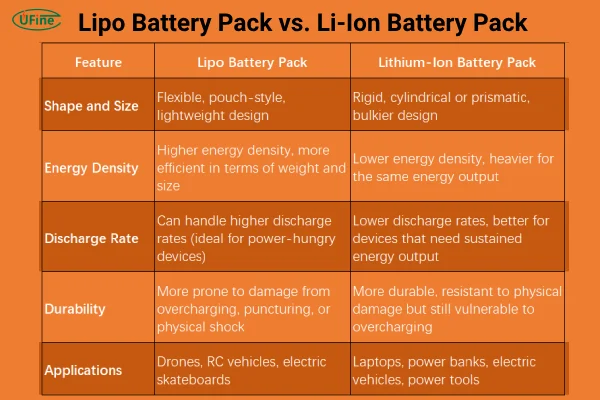Part 1. What is the lipo battery pack?
A lipo battery pack, or lithium polymer battery pack, is a type of rechargeable battery commonly used in various applications such as RC vehicles, drones, electric vehicles, and portable electronics. It’s part of the lithium-ion family but differs in its construction and performance characteristics, which make it ideal for devices that require high power output with minimal weight.
Key Characteristics of Lipo Batteries:
- Lightweight: One of the most significant advantages of lipo batteries is their lightweight nature. The battery cells are housed in a flexible, pouch-like casing rather than a hard, cylindrical case, making them much lighter than traditional batteries.
- High Energy Density: Lipo batteries offer a high energy density, meaning they can store a lot of energy relative to their size and weight. This makes them highly effective in applications where space and weight are critical, such as drones and RC cars.
- Customizable Sizes: Lipo battery packs can be tailored to specific applications, allowing users to choose the voltage and capacity that suit their needs. This flexibility is a major reason why lipo batteries are so popular in hobbyist and DIY communities.
- Higher Discharge Rates: Lipo batteries can provide higher discharge rates than their lithium-ion counterparts, making them perfect for high-performance devices that require a quick burst of energy.
Components of a Lipo Battery Pack:
A lipo battery pack is composed of several lipo cells connected together. These cells are usually made of lithium cobalt oxide or lithium iron phosphate materials, depending on the battery’s application. The cells are connected in series or parallel to create the desired voltage and capacity.
- Series Connection: This connects the positive terminal of one cell to the negative terminal of the next. The voltage increases with each cell added in series, but the capacity remains the same.
- Parallel Connection: This connects all the positive terminals together and all the negative terminals together. The voltage remains constant, but the capacity increases as more cells are added.
Additionally, most lipo battery packs contain a battery management system (BMS). The BMS protects the cells from overcharging, over-discharging, and ensures each cell is balanced, which is crucial for safe operation.
Part 2. Lipo cell vs. lipo battery pack
It’s important to understand the difference between a lipo cell and a lipo battery pack, as they’re often used interchangeably but serve different purposes. Here’s a more detailed comparison:
In essence, a lipo cell is a single battery unit with a defined voltage, while a lipo battery pack is a collection of cells that work together to provide the power necessary for more demanding applications.
Part 3. What do S and P on a lipo battery pack mean?
When looking at a lipo battery pack, you’ll often see numbers like 3S 2200mAh or 6S 5000mAh. These numbers might seem confusing at first, but they’re actually essential in understanding the pack’s configuration and performance.
S (Series)
- The S represents the number of cells connected in series. When you connect cells in series, you add up their voltages, but the capacity (measured in mAh or Ah) stays the same.
- For example, a 3S pack contains 3 cells connected in series, which gives a total voltage of 11.1V (3 x 3.7V).
- A 6S pack contains 6 cells, resulting in a voltage of 22.2V.
P (Parallel)
- The P refers to the number of cells connected in parallel. When cells are connected in parallel, their capacity increases, but the voltage stays the same.
- For example, a 2P pack would have two cells in parallel, doubling the total capacity (e.g., 2200mAh becomes 4400mAh).
- A 1P pack means the cells are arranged one by one, with no increase in capacity.
Part 4. Lipo battery pack vs lithium-ion battery pack
While both lipo and lithium-ion battery packs belong to the same family of batteries, there are significant differences that affect their performance and suitability for specific applications. Here’s a more in-depth comparison:
Lipo battery packs are typically preferred for applications that need a lightweight, high-performance battery capable of delivering quick bursts of power. In contrast, lithium-ion packs are better for long-term power supply needs, as they offer better durability and safety features.
Part 5. How to DIY a lipo battery pack
Building your own lipo battery pack might seem daunting, but with the right tools and understanding, it can be a rewarding project. Here’s how you can make your own custom battery pack:
Step 1: Gather Your Materials
- Lipo cells: Choose the cells based on your required voltage and capacity.
- Battery connectors: To link the cells together.
- Battery management system (BMS): A crucial component that ensures your cells are balanced and prevents overcharging or over-discharging.
- Welding tools: For securely connecting the cells.
- Protective casing: To keep the cells safe from physical damage.
Step 2: Connect the Cells
- Series Connection: To increase voltage, connect the positive terminal of one cell to the negative terminal of the next. For example, for a 3S pack, connect 3 cells in series to achieve 11.1V.
- Parallel Connection: To increase capacity, connect the positive terminals of all cells together and do the same for the negative terminals. This configuration keeps the voltage constant while increasing the mAh rating.
Step 3: Install the BMS
Connect the Battery Management System to ensure that each cell in the pack is balanced. This prevents issues like overcharging, which can lead to swelling or, in extreme cases, fires.
Step 4: Test the Battery Pack
Before using the pack, test it to ensure that all cells are functioning properly and that the BMS is managing the cells correctly.
Step 5: Enclose and Insulate
Once everything is connected and tested, insulate the battery pack to avoid short circuits and enclose it in a durable casing to protect it from external damage.
Part 6. Lipo battery pack charger
Charging a lipo battery pack requires a specific type of charger designed for lithium polymer batteries. Unlike regular chargers, a lipo charger includes features to balance the cells and prevent overcharging.
Key aspects of a lipo battery charger:
- Balancing Capability: Ensures that all cells in the pack are charged evenly to avoid overcharging individual cells.
- Charging Rate: Lipo chargers typically charge at a rate of 1C (where C represents the battery’s capacity), but you can charge at higher rates, like 2C, depending on the pack’s specifications.
Always use a charger that’s compatible with the voltage and capacity of your battery pack. Avoid using a charger designed for lithium-ion batteries, as it may not provide proper balancing.
Part 7. Why does lipo battery pack swell?
Swelling in lipo battery packs is a common issue and occurs when the battery undergoes internal damage or overcharging. It’s typically caused by the buildup of gas inside the battery due to chemical reactions during improper usage.
Common causes of swelling:
- Overcharging: Charging the battery beyond its maximum voltage can cause the internal chemicals to break down and release gas.
- Over-discharging: If the battery is discharged too far, it can lead to instability and swelling.
- Physical Damage: Punctures or impacts can cause internal damage, leading to swelling or leakage.
Why Do Batterry Bulge and Solutions to Li-ion Battery Bulge
If your lipo battery pack swells, stop using it immediately. Dispose of it properly, as swollen lipo batteries can be dangerous. Never puncture or attempt to drain a swollen battery.
Part 8. Charging and maintenance Tips
Proper charging and maintenance are critical for extending the lifespan of your lipo battery pack. Here are a few essential tips:
- Never overcharge: Always ensure the voltage per cell does not exceed 4.2V.
- Use a compatible charger: Only use chargers designed specifically for lipo batteries with balancing functions.
- Store correctly: When not in use, store your lipo pack at room temperature and avoid leaving it fully charged or completely discharged for long periods.
- Avoid extreme temperatures: Charge and use the battery at room temperature. Charging in hot or cold conditions can damage the battery and reduce its lifespan.
Related Tags:
More Articles
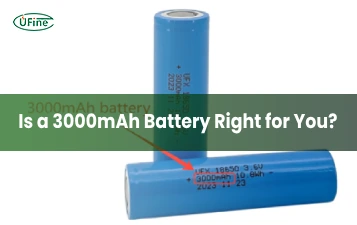
Is a 3000 mAh Lithium Battery Enough for Your Device?
Wondering what a 3000mAh battery means? Learn about its power, lifespan, types, and how to choose the best one for your device!
Learn About Lithium Battery Kits
Discover the ultimate guide to lithium battery kits—types, safety, installation, and cost analysis. Make the right choice for solar, RV, or off-grid power!
Selecting the Perfect Ah for Your 48V Li-ion Battery Pack
Struggling to choose the right Ah for your 48V Li-ion battery pack? This in-depth guide covers everything you need to make the best choice. Find out more now!
LiFePO4 Pouch Cells Explained: Advantages, Applications & Comparison
Learn all about LiFePO4 pouch cells, their structure, lifespan, advantages, and how they outperform other lithium battery types. Make the right choice!
12Ah Lithium Battery Guide: Uses, Lifespan & Tips
12Ah lithium batteries last longer, charge faster & weigh less than lead-acid. See best uses, charging tips & how to extend lifespan!
